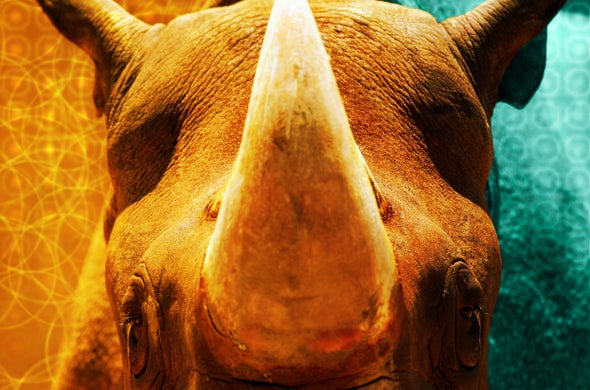(单词翻译:单击)
听力文本
This is Scientific American's 60-second Science, I'm Steve Mirsky.
"So what is the connection between AI and rhinoceri? Surprisingly direct."
Bernard Meyerson, chief innovation officer at IBM. He spoke at the Cooper Union here in New York City as part of a panel discussing the intersection of artificial intelligence (AI), ethics and healthcare. So where do rhinos come in?
"As you know, poaching rhinos is a huge problem. The rhinoceros horn represents about 30 years of revenue, 30 years of income, to an individual in sub-Saharan Africa. And that is why, basically, if you manage to kill a rhino and get a horn, it represents—it's essentially like winning the lottery. Unfortunately it's not so good for the rhino, not to mention you deplete a precious species yet again. And poaching is a huge issue...."
"What people don't know is about a thousand gamekeepers—the UN kept numbers until, I think, 2014—have been murdered by poachers in order to get at the animals being protected. This is about humans. Well, how do you basically protect rhinos with AI? Well, that's a good question. Somebody said, you know, being a kid who grew up in the Bronx my thought was, well, you know, you put a collar on the rhino, analyze where they are, their travel patterns. And the guy who ran the reserve in South Africa sort of laughed, said, 'This does not help.'"
That's the Welgevonden Game Reserve. Back to Meyerson.
"I said, 'Why?' He says, 'Well, when the rhino stops moving you'll know it was dead. That's really not helpful.'"
"'Obviously you have a better idea.' He says, 'Yeah, what you do is, get a bunch of animals that are easily spooked, like gazelles, antelopes, that sort of thing, and what you do is you collar them.' You looked at that, and we thought about it and said, that's brilliant, because they become sentinels. Because you see, when a poacher enters an area that it will encounter these creatures, it's not going to encounter rhinos, they're by far more rare. When they encounter the creatures, like any other animal they spook and run."
"Where does AI come in? Well, turns out when you have these collars on them, there's really a bunch of reasons these animals run: they migrate, some leopard is trying to make lunch out of it, and yes, they're spooked by somebody who's coming, entering in a truck to go poach."

"You have to know the difference. And it turns out by looking at the pattern of movements and looking at historic data, we were able to tell the difference between each of that using a system that essentially employed machine learning to separate, yep, these are incidents where we're running into poachers, these are incidents where we're actually just—there's a lion trying to make lunch out of this poor animal."
"The bottom line is by doing that we were able to spot the poachers when they were nowhere near the preserve, much less on the preserve where the rhinos are. And this avoids the kind of conflict where people ended up dead in large numbers, not just the rhinos.... Basically, the idea is that nobody dies. You don't want the poachers to die—they are desperate. You don't want the rhinos to be killed—we lose a species. And of course, the people who are incredibly brave protecting these animals ... it really was an amazing thing to us because at the end of the day it worked. And that's the kind of thing where, you know, AI used sensibly adds value that no human could possibly have achieved...."
"It's not just about healthcare ... where you're trying to help somebody diagnose a better way to live. You're talking about saving lives in large quantities. So I consider the fact that we're trying not to have a thousand of these caretakers murdered a very high bar for health care."
For Scientific American — 60-Second Science. I'm Steve Mirsky.
参考译文
这里是科学美国人——60秒科学系列,我是史蒂夫·米尔斯基。
“人工智能与犀牛之间有什么联系呢?二者的联系惊人地直接。”
IBM首席创新官伯纳德·迈尔森说到。在纽约市库伯联盟学院,他作为人工智能、伦理和医疗交叉问题小组的成员发表了讲话。那这与犀牛有何关系?
“如你所知,偷猎犀牛是个巨大的问题。对撒哈拉以南非洲地区的个人来说,犀牛角代表着其大约30年的收入。也就是说,如果你能设法杀掉犀牛并得到犀牛角,那你基本上就等于中彩票了。不幸的是,这对犀牛并没那么好,更不用提你再一次删除了一个珍贵物种。所以说偷猎是个巨大的问题。”
“人们不知道的是,大约1000名猎场看守人被希望得到受保护动物的偷猎者杀害,我记得,联合国直到2014年才公布这一数据。这关乎人命。那如何用人工智能来保护犀牛?这是个好问题。有人说……作为在布鲁克长大的孩子,我本来以为给犀牛套上颈圈后,分析它们的位置和行动模式就可以了。但在南非运营保护区的一个人笑着说,‘这没用’。”
刚才提到的是南非威尔盖凡登保护区。下面回到迈尔森的讲话。
“我问,‘为什么没用?’他说,‘犀牛停止不动时,你就会知道它死了。这真的没用。’”
“我说,‘显然你有更好的主意。’他说,‘没错,你要做的是,找来一群容易受惊吓的动物,比如瞪羚和羚羊,然后给它们套上颈圈。’看看这个主意,我们认为这真不错,因为它们成为了哨兵。偷猎者进入保护区后,会遇到这些动物,而不会遇到犀牛,因为犀牛比其它动物要稀少得多。他们遇到这些动物时,像其它动物一样,它们也会受惊然后逃走。”
“那人工智能如何发挥作用?结果表明,当你给这些动物套上颈圈后,会发现它们会因为很多情况而逃跑:它们会迁徙,有些豹子会试图将它们当做午餐,它们还会被开卡车进保护区的偷猎者而吓得四处逃窜。”
“你必须知道其中的区别。结果表明,通过观察动物的运动模式和历史资料,我们能利用系统来区分每种模式的区别,而该系统本质上采用机器学习原理,以区分哪些事件是遇到偷猎者了,哪些事件只是狮子在试图让这个可怜的动物成为其午餐。”
“这样做最重要的是,偷猎者还在离保护区很远的地方时,我们就能发现他们,更不用说他们在犀牛保护区内了。这可以避免最终导致大量死亡的那种冲突,不只是犀牛,还有人类。这种想法基本不会造成人员死亡。你不希望偷猎者死亡——他们在铤而走险。你也不希望犀牛被杀死——因为这会使我们失去一个物种。当然,还有那些勇敢地保护这些动物的人们,这对我们来说是一件不可思议的事情,因为它最终奏效了。这就是那种事情,即用人工智能合理增加人们不可能实现的价值。”
“这不仅仅关乎医疗,不仅是你试图帮助他人找到更好的生活方式。你讨论的是拯救大量生命的事情。因此,我认为我们正在努力让1000名看守人免遭杀害,这对医疗来说是非常高的标准。”
谢谢大家收听科学美国人——60秒科学。我是史蒂夫·米尔斯基。
译文为可可英语翻译,未经授权请勿转载!
重点讲解
重点讲解:
1. get at 触及;够得着;抓住;
I should like to get at some of the papers in that drawer.
我想拿到那个抽屉里的某些文件。
2. run into 意外碰到;
He ran into Krettner in the corridor a few minutes later.
几分钟之后他在走廊里意外碰到了克雷特纳。
3. nowhere near 远非;远不及;
It's nowhere near the colour I'm looking for.
这种颜色跟我找的那种差远了。
4. at the end of the day 最终;到头来;
At the end of the day, the board's not going to be too concerned with three or four more dollars.
到头来,董事会不会太操心多花了几个钱。


